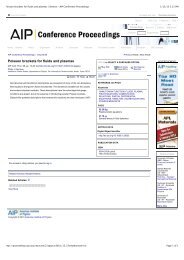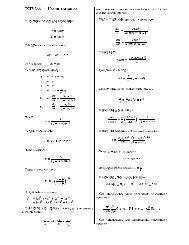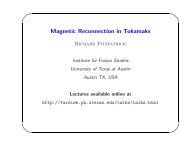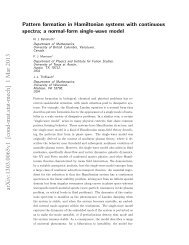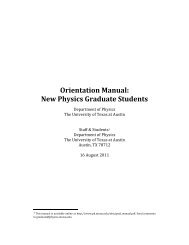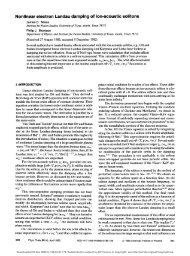Magnetic Fields and Magnetic Diagnostics for Tokamak Plasmas
Magnetic Fields and Magnetic Diagnostics for Tokamak Plasmas
Magnetic Fields and Magnetic Diagnostics for Tokamak Plasmas
Create successful ePaper yourself
Turn your PDF publications into a flip-book with our unique Google optimized e-Paper software.
<strong>Magnetic</strong> fields <strong>and</strong> tokamak plasmas<br />
Alan Wootton<br />
In reality µ is not infinite, but the limit works well.<br />
First consider an air gap inductor, as shown in Figure 20.2. We assume that inside the iron there<br />
are laminations which ensure no current, so that<br />
∇ × H = 0 20.4<br />
Then H is derived from a single valued potential given by Laplace's equation<br />
∇ 2 ψ = 0 20.5<br />
<strong>and</strong> the boundary condition on B n (Equation 20.2) is equivalent to<br />
∂ψ<br />
∂n<br />
= 0 in the iron. 20.6<br />
The only possible solution of equation 20.5 <strong>and</strong> equation 20.6 is ψ = constant . There<strong>for</strong>e H (but<br />
not B) must be zero inside the iron. Continuity of the tangential component of H then shows that<br />
the lines of <strong>for</strong>ce in the air must be perpendicular to the iron. There<strong>for</strong>e in air the magnetic fields<br />
are given by the usual equations, together with the boundary condition<br />
e n<br />
× H = 0 on the iron surface. 20.7<br />
In the iron H = 0, but B is finite. Since ∇xB = 0 in the iron, B(iron) = ∇Φ, <strong>and</strong> Φ satisfies<br />
∇ 2 Φ = 0 20.8<br />
∂Φ<br />
∂n = B n( air) 20.9<br />
which is known.<br />
contour l<br />
iron<br />
I<br />
145



